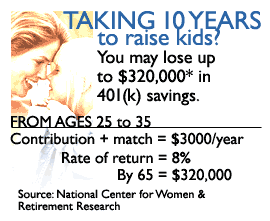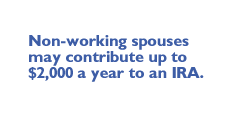|
Retirement plans for moms
|
 |
February 28, 2000: 7:41 a.m. ET
Give your all to your kids, but for all concerned protect your retirement plan
By Staff Writer Jeanne Sahadi
|
NEW YORK (CNNfn) - You and your husband have done the math and found that you can afford to stay home for a few years to run Bambinos Ltd. Or perhaps you discovered it just doesn't pay to hire full-time caregivers.
Either way, when you draw up the one-salary family budget, make sure to include contributions to your retirement plan.
Having a child may mark the first time you put your job aside, but it's not necessarily your last. Retirement studies show that women move in and out of the work force far more than men because of the demands of child care, elder care and spouse relocation.
And that costs you professionally and economically. But there are some things you can do to minimize the damages.
Tally the losses

First, account for what you're giving up.
In addition to earnings, factor in the loss of tax-deferred employer-match plans and pension contributions.
If, for instance, between the ages of 25 and 35 you contributed $2,000 a year to a 401(k) plan and your employer matched you at 50 percent, by the time you turned 65 those contributions would total $320,000, assuming an 8 percent annual return, said Christopher L. Hayes, director of the National Center for Women & Retirement Research.
You also may lose out on Social Security benefits. The formula for calculating benefits is based on your best 35 years of earnings, so there is some allowance for time off. But if it happens during your prime earning years, your overall average will be lower, said Arnaa Alcon, a research associate at the National Center on Women and Aging. On the plus side, you will have the option to receive the equivalent of half your husband's benefits should they be higher than yours.
Don't forget, too, the price of starting over. Taking a new job after the kids enter school means you may need to wait a year or more before you fully vest for retirement benefits.
Minimize the minus signs
So what should you do to minimize damage to your nest egg?
One is to leave your retirement plans intact when you quit a job. Too often, women will cash out their 401(k) or pension plan when they leave work to raise children, said Lena M. Lundgren, director of the Center on Work and Family at Boston University.
 Budget for your own IRA contributions, too. Thanks to a recent change in the tax law, non-working spouses are now allowed to contribute up to $2,000 a year, said certified public accountant Carol E. Jensen. That limit used to be just $250 a year. Budget for your own IRA contributions, too. Thanks to a recent change in the tax law, non-working spouses are now allowed to contribute up to $2,000 a year, said certified public accountant Carol E. Jensen. That limit used to be just $250 a year.
"Set aside as much as you can in a tax-sheltered plan," Jensen advised.
And be sure your family is fully covered by all your husband's insurance plans, and not just the medical plans. A long-term illness or premature death can decimate savings.
"Spouses need to talk quite extensively about how they're going to pick life insurance and disability benefits," said Christopher L. Hayes, director of the National Center for Women & Retirement Research.
Keep one foot in the work force
One of the best things you can do, experts agree, is to keep one foot in the working world -- whether that means working part-time or as a consultant, or taking courses to enhance your skills.
More than money, the work gives you a long-term advantage. You still may not qualify for pensions or 401(k) contributions, but having a continuous work history often helps you command a decent salary and a good benefits package when you do re-enter the job market full time.
And keeping current with your profession can help buffer you against devastating personal loss.
Divorce, like death and disability, is not just something that happens to others. Any of the three can change your economic situation drastically, especially when you're not pulling in your own salary.
"Most families are not as stable long term as we think they are," Lundgren said. That's why, she added, it's smart to stop thinking you're in a static category.
More opportunity, but still tough choices
The good news is there is greater support for alternative work situations.
"There's a new flexibility in today's economy," Lundgren said.
But, not so much so that you don't risk losing some professional status and savings. A lot of companies still don't provide women the kinds of choices they need to balance their work and family lives.
"It might be the case that more women would go back to work if they had more options to do that," said Mary Mattis, senior research fellow at Catalyst, a nonprofit research organization that works with business to advance women. "Even companies that have good policies don't always hold managers accountable for them."
And that often means women look for new jobs rather than battle it out at their old ones.
These disadvantages may not seem so dire when you're staring at your gurgling wonder of a child, who cannot say just yet how much he or she appreciates your sacrifices.
But, making your financial security as high a priority as your children's well being is just as much in their best interest as it is in yours. 
|
|
|
|
|
 |

|

